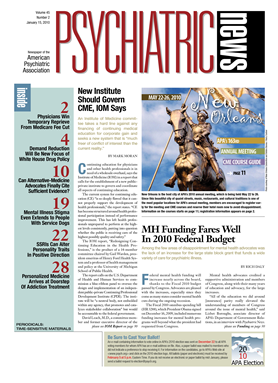Continuing education for physicians and other health professionals is in need of a wholesale overhaul, says the Institute of Medicine (IOM) in a report that calls for the establishment of a new public-private institute to govern and coordinate all aspects of continuing education.
The current system for continuing education (CE) “is so deeply flawed that it cannot properly support the development of health professionals,” the report states. “CE has become structured around health professional participation instead of performance improvement. This has left health professionals unprepared to perform at the highest levels consistently, putting into question whether the public is receiving care of the highest possibly quality and safety.”
The IOM report, “Redesigning Continuing Education in the Health Professions,” is the product of a 14-member committee chaired by Gail Warden, president emeritus of Henry Ford Health System and a professor of health management and policy at the University of Michigan School of Public Health.
The report calls on the U.S. Department of Health and Human Services to commission a blue-ribbon panel to oversee the design and implementation of an independent public-private Continuing Professional Development Institute (CPDI). The institute will be “a neutral body, not embedded within any agency, that promotes and catalyzes stakeholder collaboration” but would be accountable to the federal government.
David Leach, M.D., a committee member and former executive director of the Accreditation Council for Graduate Medical Education, said reorganization of CE was vital to health system quality and overall health system reform.
“All of us felt and articulated in one way or another that health-professional development, the quality of patient care, and health system reform are inextricably linked,” Leach said in a Webcast news conference last month announcing the report. “We really felt an urgent need for a new model of continuous professional development. Most health care professionals do not know how they are doing—we cannot answer that question as individual professionals or as an inter-professional community.”
The report highlights six critical problems with the current structure of CE:
•.
Health professionals and their employers tend to focus on meeting regulatory requirements rather than identifying personal-knowledge gaps and finding programs to address them.
•.
The current approach to CE is most often characterized by didactic learning methods, such as lectures and seminars; traditional settings, such as auditoriums and classrooms; and teacher-driven content that may or may not be relevant to the clinical setting.
•.
CE is operated separately in each profession or specialty, with responsibility dispersed among multiple stakeholders within each of those communities.
•.
The scientific literature offers guidance about general principles for CE but provides little specific information about how to best support learning.
•.
Pharmaceutical and medical-device companies have taken a lead role in financing CE, raising concerns about whether some companies are using CE to influence health professionals to increase market share.
•.
Regulations vary widely by specialty and by state for licensure, certification and credentialing, leading to inconsistent learning.
Committee members considered several possibilities regarding a new institute that could reform CE: maintaining the status quo; a new program within an existing government agency, such as the Agency for Healthcare Research and Quality or the Health Resources and Services Administration; an ad hoc coalition of current stakeholders and organizations; a private structure operated by professional societies and organizations; or a new public-private structure.
The committee opted for the public-private structure, saying it could catalyze participation of a broad set of stakeholders, but would also be accountable to the federal government. The 183-page report is devoted to discussion of that option and outlines recommendations for the functioning of the new institute.
Committee members were drawn largely from academic institutions and medical centers and had expertise in medicine, nursing, health policy and management, pharmacy, and social work. There were also representatives from the American Association of Colleges of Pharmacy, Robert Wood Johnson Foundation, and National Center for Healthcare Leadership; a 13-member panel that reviewed the report was similarly constituted, with one representative from Pfizer Inc.
In response to a question about the role of industry in the report and in the future of continuing education, Leach emphasized the intense public and regulatory concerns about conflict of interest that have shaken much of medicine in recent years.
“We have taken great care to categorize conflicted sources of financing and to warn against [any form of financing of CE] that was in any way advertising for corporate gain,” he said. “We took a hard line on this and anticipate that the planning committee and founding board [of the new institute] would develop policies and procedures to ensure a system that is much freer of conflict of interest than the current reality.”

